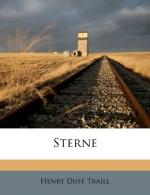But before we finally cross the line which separates the life of the obscure country parson from the life of the famous author, a word or two must be said of that piece of writing which was alluded to a few pages back as the only known exception to the generally “professional” character of all Sterne’s compositions of the pre-Shandian era. This was a piece in the allegoric-satirical style, which, though not very remarkable in itself, may not improbably have helped to determine its author’s thoughts in the direction of more elaborate literary efforts. In the year 1758 a dispute had arisen between a certain Dr. Topham, an ecclesiastical lawyer in large local practice, and Dr. Fountayne, the then Dean of York. This dispute had originated in an attempt on the part of the learned civilian, who appears to have been a pluralist of an exceptionally insatiable order, to obtain the reversion of one of his numerous offices for his son, alleging a promise made to him on that behalf by the Archbishop. This promise—which had, in fact, been given—was legally impossible of performance, and upon the failure of his attempt the disappointed Topham turned upon the Dean, and maintained that by him, at any rate, he had been promised another place of the value of five guineas per annum, and appropriately known as the “Commissaryship of Pickering and Pocklington.” This the Dean denied, and thereupon Dr. Topham fired off a pamphlet setting forth the circumstances of the alleged promise, and protesting against the wrong inflicted upon him by its non-performance. At this point Sterne came to Dr. Fountayne’s assistance with a sarcastic apologue entitled the “History of a good Warm Watchcoat,” which had “hung up many years in the parish vestry,” and showing how this garment had so excited the cupidity of Trim, the sexton, that “nothing would serve him but he must take it home, to have it converted into a warm under-petticoat for his wife and a jerkin for himself against the winter.” The symbolization of Dr. Topham’s snug “patent place,” which he wished to make hereditary, under the image of the good warm watchcoat, is of course plain enough;




